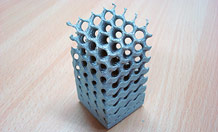University of Exeter Researches Aluminum Composites

Complex 3D printed object created using techniques developed at the University of Exeter. Courtesy of the University of Exeter.
Latest News
July 13, 2012
Additive manufacturing (AM) runs on materials, both figuratively and literally. A machine could have the fastest build times and largest build envelopes ever, but if it isn’t capable of producing objects from materials relevant to customers, no one cares. Nearly as much effort is put into researching AM materials as is designing new systems.
Researchers from the University of Exeter have recently published a paper in the Journal of Alloys and Compounds, documenting their work with aluminum composites for use in AM, specifically for use in laser sintering.
Aluminum is commonly used to manufacture parts in the automotive and aerospace industries. As has been said before, the main appeal of aluminum is its light weight. Reduced weight means lower fuel consumption, which leads to reduced cost of operation.
The goal of the Exeter researchers was to find specific powder mixes of aluminum and other metals. By mixing in an iron oxide combination (for example) the team found they were able to build objects with complex geometries that retained the light weight of aluminum, but were more durable.
“This new development has great potential to make high performance parts for car manufacturing, the aerospace industry and potentially other industries,” said Sasan Dadbakhsh, University of Exeter PhD student. “Additive layer manufacturing technologies are becoming increasingly accessible, so this method could become a viable approach for manufacturing.”
The method developed by Exeter researchers makes building complex geometries easier.
The new materials have very fine particles compared with other composites, making them more robust. The reaction between constituents releases energy, which also means materials can be produced at a higher rate using less power. This technique is significantly cheaper and more sustainable than other SLM methods, which directly blend very fine powders to manufacture composites. –University of Exeter
Below you’ll find a video that discusses some facts about aluminum.
Source: University of Exeter
Subscribe to our FREE magazine, FREE email newsletters or both!
Latest News
About the Author
John NewmanJohn Newman is a Digital Engineering contributor who focuses on 3D printing. Contact him via [email protected] and read his posts on Rapid Ready Technology.
Follow DE






